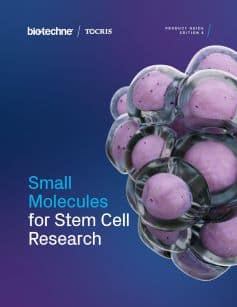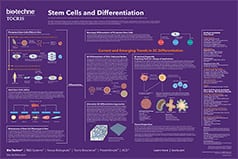Stem Cell Signaling
Various stem cell signaling pathways influence stem cell generation, self-renewal and differentiation. In vivo, the microenvironment responsible for maintaining stem cells in pluripotent form and enabling their self-renewal is called the stem-cell niche.
| Cat. No. | Product Name / Activity |
|---|---|
| 1515 | 17-AAG |
| Selective Hsp90 inhibitor; protects neuroprogenitor cells against stress-induced apoptosis | |
| 3979 | Alexidine dihydrochloride |
| Selective inhibitor of PTPMT1; maintains functional HSCs ex vivo | |
| 3299 | AMD 3100 octahydrochloride |
| Highly selective CXCR4 antagonist; mobilizes hematopoietic stem cells in vivo | |
| 3194 | BIO |
| Maintains self-renewal and pluripotency of ESCs; potent inhibitor of GSK-3; also inhibits cdks | |
| 5051 | BIO 5192 |
| Integrin α4β1 inhibitor; mobilizes HSCs and progenitors | |
| 6047 | BOP |
| Preferentially mobilizes HSCs; dual α9β1/α4β1 integrin inhibitor | |
| 6997 | BOP-JF646 |
| Red fluorescent dual α9β1/α4β1 integrin inhibitor;BOP conjugated to Janelia Fluor® 646; fluorogenic; photostable | |
| 5050 | CASIN |
| Cdc42 GTPase inhibitor; functionally rejuvenates aged HSCs | |
| 4529 | Ciliobrevin A |
| Hedgehog pathway antagonist; inhibits ciliogenesis | |
| 1623 | Cyclopamine |
| Inhibitor of Hedgehog (Hh) signaling; depletes stem-like cancer cells in glioblastoma | |
| 4027 | 16,16-Dimethyl Prostaglandin E2 |
| Synthetic prostaglandin E2 (Cat. No. 2296) derivative; regulates HSC development | |
| 3191 | GANT 61 |
| GLI antagonist; inhibits Hh signaling | |
| 1368 | Geldanamycin |
| Selective Hsp90 inhibitor; breast cancer stem cell inhibitor | |
| 4474 | 20(S)-Hydroxycholesterol |
| Allosteric activator of Hedgehog signaling; induces Smo accumulation | |
| 3533 | IWP 2 |
| PORCN inhibitor; suppresses self-renewal in R1 ESCs and promotes cardiomyocyte differentiation | |
| 3532 | endo-IWR 1 |
| Wnt/β-catenin signaling inhibitor; axin stabilizer | |
| 3603 | Kaempferol |
| TAZ activator; promotes osteogenesis from MSCs; also activates mitochondrial Ca2+ uniporter | |
| 3258 | Mitomycin C |
| Used for MEF/STO feeder layer preparation in stem cell culture | |
| 5522 | Napabucasin |
| STAT3 inhibitor; blocks cancer stem cell self-renewal | |
| 4079 | Niclosamide |
| STAT3 and mTORC1 signaling inhibitor; antineoplastic against AML stem cells | |
| 1267 | Pifithrin-α hydrobromide |
| p53 inhibitor; supresses self renewal of embryonic stem cells | |
| 2296 | Prostaglandin E2 |
| Major endogenous prostanoid | |
| 3324 | QS 11 |
| ARFGAP1 inhibitor; modulates Wnt signaling pathway | |
| 3667 | SR 3677 dihydrochloride |
| Potent, selective Rho-kinase (ROCK) inhibitor | |
| 7340 | Tocriscreen Stem Cell Library |
| A library of 120 stem cell compounds (100 μL 10 mM DMSO solutions) to explore stem cell reprogramming, differentiation, proliferation and signaling | |
| 4855 | WIKI4 |
| Tankyrase inhibitor; inhibits Wnt signaling | |
| 3748 | XAV 939 |
| Tankyrase inhibitor; promotes cardiomyogenesis |
Stem cell generation, self-renewal and differentiation are controlled by various intra- and extracellular cues. In vivo, the microenvironment responsible for maintaining stem cells in pluripotent form and enabling their self-renewal is called the stem-cell niche. Environmental factors and certain signal pathways, such as the Wnt, JAK-STAT and TGF-β/BMP pathways, contribute to the maintenance of this niche.
Communication between the stem cells within this environment helps coordinate the process of differentiation, after it is triggered by signal molecules such as growth factors and Wnt proteins. Signaling pathways closely linked to developmental processes, and which are frequently dysregulated in cancer - e.g. Notch, Hedgehog and Wnt - have also been linked with the regulation of stem cell self-renewal. Internal signals, controlled by the cell's genes, play an equally important role in stem cell differentiation. While these signaling pathways are integral to the generation of specific differentiated cells, the mechanisms that determine differentiated cell type and destination are not entirely understood.
Key Stem Cell Signaling Pathways

Figure 1: Schematic highlighting some of the key signaling pathways in stem cells. The proliferation and differentiation of stem cells are controlled by a network of signaling pathways. These pathways can be readily manipulated using small molecules (represented here in blue). Abbreviations: BMP, Bone morphogenetic protein; CK1, casein kinase 1; β-cat, β-catenin; DVL, Dishevelled; FGF, Fibroblast growth factor; FZD, Frizzled receptor; GSK, glycogen synthase kinase-3β; Hh, Hedgehog; NICD, Notch intracellular domain; PKA, protein kinase A; PORCN, Porcupine; PTCH, Patched receptor; SMO, Smoothened receptor; TGFβ, Transforming growth factor β.
Other signals result in the reprogramming of differentiated cells, generating embryonic stem-like cells. Transcription factors such as Oct4, Sox2 and Nanog regulate the expression of selected induction genes and are used to create pluripotent cells. These induced pluripotent stem cells (iPSCs) provide a viable alternative to embryonic stem cells (ESCs), without the moral issues affecting human ESC use. Recent research has moved away from the use of viruses and oncogenes to genetically alter adult cells; instead, recombinant proteins and chemicals have been used successfully to generate murine and human iPSCs (protein-induced pluripotent stem cells). The fusion of pluripotent cells with somatic cells also enables the transfer of pluripotent phenotype by an unknown mechanism.
Literature for Stem Cell Signaling
Tocris offers the following scientific literature for Stem Cell Signaling to showcase our products. We invite you to request* your copy today!
*Please note that Tocris will only send literature to established scientific business / institute addresses.
Stem Cells Scientific Review
Written by Kirsty E. Clarke, Victoria B. Christie, Andy Whiting and Stefan A. Przyborski, this review provides an overview of the use of small molecules in the control of stem cell growth and differentiation. Key signaling pathways are highlighted, and the regulation of ES cell self-renewal and somatic cell reprogramming is discussed. Compounds available from Tocris are listed.
Stem Cell Workflow Poster
Stem cells have potential as a source of cells and tissues for research and treatment of disease. This poster summarizes some key protocols demonstrating the use of small molecules across the stem cell workflow, from reprogramming, through self-renewal, storage and differentiation to verification. Advantages of using small molecules are also highlighted.






